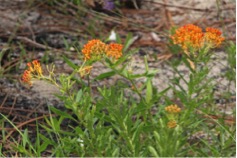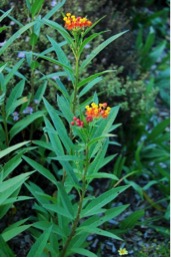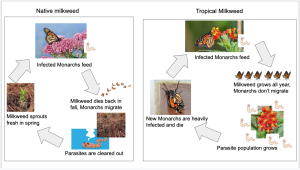Monarchs are big, showy orange butterflies. Seeing one skip through your garden inevitably brings a smile to both young and old. How can we lure these beauties to our back yard where we can enjoy the lift they bring to our days? Planting butterfly-attracting flowering plants is a good start (no pesticides, please!). The adult butterflies will flit from flower to flower, sipping the sweet treat within. But what else is needed?
All wildlife – birds, animals, and yes, butterflies – need three things: food, water, and a place to raise a family. Nectar-rich flowers provide food. A shallow dish with pebbles can hold water. But monarchs have a very specific requirement for raising their young: milkweed. Milkweed is slightly toxic, and the monarch caterpillars munch it and become toxic themselves, which keeps them from being eaten. Their bright orange color is a warning to predators, and other non-toxic butterflies such as the queen and viceroy mimic it.

Monarchs lay a single egg at a time on the underside of a milkweed leaf.

The egg hatches into a larva.

The larva molts and becomes the familiar striped monarch caterpillar. So what kinds of milkweed can we grow in our yard? There are several native milkweeds that will support the monarchs. Here are some selections.

Swamp milkweed (Asclepias incarnata) has pink flowers and can grow into a large plant, up to five feet tall. It needs sun or part shade and lots of water, which makes it a great choice to plant near a downspout, by a pond, or in a low spot in your landscape. It will bloom summer through fall. Swamp milkweed is one of the most adaptable species of native milkweeds to grow in home gardens.

Butterfly weed (Asclepias tuberosa), also called butterfly milkweed, has orange or yellow flowers and grows about two feet tall. It likes sun or part shade and is drought tolerant, so once established it can live in dry, sandy spots. Avoid overhead watering. It blooms in summer and early fall, providing a nectar source after the spring blooming flowers are done. In winter it will disappear but will grow back in late spring.

Aquatic milkweed (Asclepias perennis) has white or pink flowers and is fairly short, about two feet tall. It normally grows in swamps, so it’s a good choice for water gardens, ponds, ditches, or other constantly wet spots that get full sun. It blooms from spring to late summer. Find these milkweeds at native plant nurseries. A list of retail native nurseries is available at https://www.afnn.org/.

What about the non-native tropical milkweed (Asclepias curassavica)? Tropical milkweed is commonly found in garden centers and is easy to grow. However, there are some drawbacks. Sometimes the plants in big box stores are actually treated with pesticides – not a good thing for the caterpillars that want to munch on them! Be sure to check the label carefully.
Unlike native milkweeds, tropical milkweed grows year-round in Central Florida. Since there is a ready food source, this encourages the monarch to stay all winter instead of migrating to Mexico. Scientists are divided on whether or not this is a good thing. Warmer winters mean that the monarch probably won’t freeze to death if they stay. However, some scientists believe that when monarchs don’t migrate, it makes them more susceptible to a disease called Ophryocystis elektroscirrha or OE.

Does planting tropical milkweed result in increased disease? We don’t know yet. Research is ongoing. Current recommendations say to cut this milkweed back to the ground once a year to stop any possible disease buildup. You can cut back part of it at a time, so the butterflies still have blossoms. Non-native tropical milkweed may cause disease buildup in monarchs. Current recommendation is to cut it back once a year to decrease risk of disease.

Another type of nonnative milkweed is the Giant Milkweed, also known as Crown Flower and scientifically known as Calotropis gigantea. It is native to Asia and tropical Africa. It is a perennial shrub that grows in tropical and subtropical areas to 15’ tall and 15′ wide. The plant is an irregular grower with large hairy leaves and requires regular pruning to look properly shaped. Learn more about the giant milkweed shrub in this blog https://blogs.ifas.ufl.edu/orangeco/2021/02/28/giant-milkweed-a-big-milkweed-for-monarch-caterpillars/.
Sometimes, you may see tiny yellow or orange bugs on the milkweed stems. These are oleander aphids, and they only like a few kinds of plants – mostly oleander and milkweed. A few won’t really damage your plant, and the monarch caterpillars will eat the leaves right out from under them. If there are a lot of aphids, you can prune off heavily infested branches, or knock the insects off with a strong stream of water. Don’t use pesticides! That could hurt any monarch caterpillars that might be on the plant.
Want to learn more? Follow us on Facebook http://www.facebook.com/GardenFlorida. Check out butterfly classes offered by UF/IFAS Extension Orange County at www.ocextension.eventbrite.com. Read about attracting birds and butterflies with Florida-Friendly Landscaping™ at https://ffl.ifas.ufl.edu/.
This blog post was co-written by UF/IFAS Extension Orange County Master Gardener Volunteer, Mary Ann Pigora, class of 2017. The UF/IFAS Extension Orange County Master Gardener Volunteers play a crucial role in the outreach of UF/IFAS Extension.
 3
3
